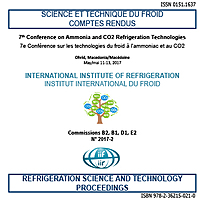
IIR document
Performance simulation of a refrigerated sea water system for salmon chilling with R744 as the refrigerant.
Number: pap. n. 0032
Author(s) : TOLSTOREBROV I., EIKEVIK T. M., HAFNER A., et al.
Summary
The aquaculture production is steadily increasing in Norway. Typical load during one working shift reaches up to 100 metric tons of fish. The requirements for fish chilling is strict: the process should be as fast as possible and the final temperature in the centre of the fish should not exceed +2.0 °C. Typical chilling system are using refrigerated sea water in direct contact with the product and the cooling load is varying with product size, production rate and seasonal temperature. This case study evaluates the performance of CO2 as refrigerant in refrigerated sea water (RSW) system for chilling of salmon. The system was evaluated for different weight classes of fishes being chilled (from 3.0 to 8.0 kg). The knowledge of heat transfer and temperature fields inside the fish, which was obtained in another study, was used for simulation of the process in order to optimize the operation conditions for the system. System solutions with the highest rate of cooling capacity together with low energy consumption during operation are described and evaluated.
Available documents
Format PDF
Pages: 7
Available
Public price
20 €
Member price*
Free
* Best rate depending on membership category (see the detailed benefits of individual and corporate memberships).
Details
- Original title: Performance simulation of a refrigerated sea water system for salmon chilling with R744 as the refrigerant.
- Record ID : 30021787
- Languages: English
- Source: 7th Conference on Ammonia and CO2 Refrigeration Technology. Proceedings: Ohrid, North Macedonia, May 11-13, 2017.
- Publication date: 2017/05/11
- DOI: http://dx.doi.org/10.18462/iir.nh3-co2.2017.0032
- Document available for consultation in the library of the IIR headquarters only.
Links
See other articles from the proceedings (42)
See the conference proceedings
Indexing
-
Themes:
CO2;
Fish and fish product - Keywords: Heat transfer; Chilling; R744; Aquaculture; Simulation; Salmon; Norway; Case study; COP
-
Energy consumption for salmon slaughtering proc...
- Author(s) : ATES B., WIDELL K. N., NORDTVEDT T. S., et al.
- Date : 2017/05/11
- Languages : English
- Source: 7th Conference on Ammonia and CO2 Refrigeration Technology. Proceedings: Ohrid, North Macedonia, May 11-13, 2017.
- Formats : PDF
View record
-
Design and simulations of refrigerated sea wate...
- Author(s) : BODYS J., SMOLKA J., BANASIAK K., et al.
- Date : 2018/06/18
- Languages : English
- Source: 13th IIR Gustav Lorentzen Conference on Natural Refrigerants (GL2018). Proceedings. Valencia, Spain, June 18-20th 2018.
- Formats : PDF
View record
-
Temperature control in salmon processing.
- Author(s) : MAGNUSSEN O. M., NORDTVEDT T. S.
- Date : 1999/09/19
- Languages : English
- Source: 20th International Congress of Refrigeration: Refrigeration into the Third Millennium.
- Formats : PDF
View record
-
Pre-mortal chilling of farmed salmon.
- Author(s) : SKJERVOLD P. O., FJAERA S. O., CHRISTOFFERSEN K.
- Date : 1996/03/20
- Languages : English
- Source: Refrigeration and Aquaculture.
- Formats : PDF
View record
-
Sustainability assessment of novel salmon produ...
- Author(s) : IORDAN C-M., VIKEN STRAND A., MEHTA S.
- Date : 2024/06/11
- Languages : English
- Source: 8th IIR International Conference on Sustainability and the Cold Chain. Proceedings: June 9-11 2024
- Formats : PDF
View record
